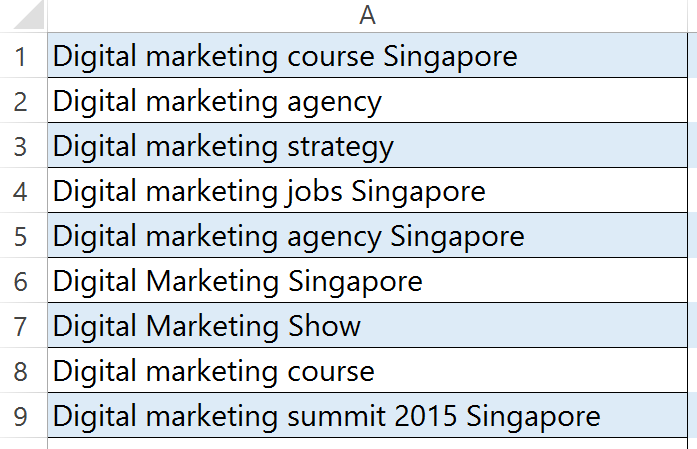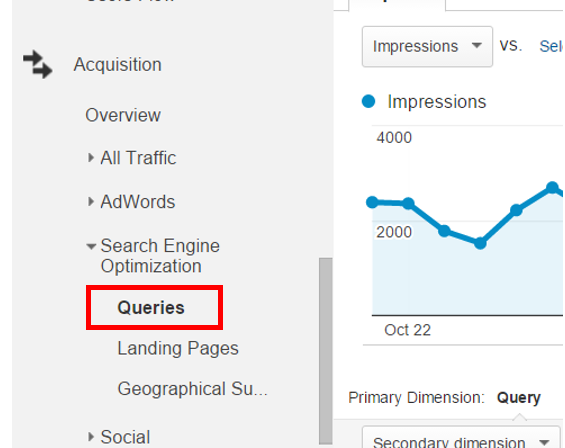From an online business perspective, there are different techniques used to identify the audience of your business. The key is to narrow down your audience. Your audience will hopefully have problems they are desperately attempting to solve. I’ll walk through a few of these techniques.
1. Keyword Analytics
The first technique I’ll cover is keyword analytics. Users searching through Google Search already have intent. They are looking for something specific. The longer the keyword phrase used in the search the more clearer the intent.
For example when a user types in the phrase “Digital Marketing” vs the phrase “Digital Marketing certification”, the second phrase give you clearer intent. A tool called Keywordtool.io uses the autocomplete feature of Google to tell us what users are searching for by location.
Using this tool, I type “Digital Marketing” for google.com.sg and for location Singapore. The following keyword phrases are returned:

This gives us clarity in terms of user intent.
Goo gle Keyword planner is a must tool to use to determine how much your keywords are going to cost in a Google Adwords Advertising campaign. Keyword planner gives an estimated dollar value for Cost per click and Click through rate for the keywords you plan to use in an Adword campaign. In addition it also gives you an estimate of monthly searches for the same keywords.
gle Keyword planner is a must tool to use to determine how much your keywords are going to cost in a Google Adwords Advertising campaign. Keyword planner gives an estimated dollar value for Cost per click and Click through rate for the keywords you plan to use in an Adword campaign. In addition it also gives you an estimate of monthly searches for the same keywords.
Keywords and search phrases that were used in Google search to arrive at your site are also available in Google Analytics. This data is accessible from the following set of menu items in Google Analytics: Acquisition -> Search Engine Optimization -> Queries

2. Execute Online Survey
Having your potential customers take an online survey (or even a regular survey) is a technique that is very time consuming but the results from a good survey are invaluable. You can get clear insights in terms of your potential customers. The main issue with surveys is the lack of participation; people would like to avoid doing them. To get around this problem, offer simple prizes to survey participants.
Also, keep the following in mind when designing your survey:
1. Keep your questions simple
2. Ask close ended questions wherein the participant ideally has to choose simply between A and B.
3. Ask sensitive questions last.
4. Have a logical ordering of your questions: You can perhaps start from broader based questions to simpler questions.
3. Form Customer Personas
As a starting point in creating customer personas you can use Google Analytics. Google Analytics gives you access to demographic data of the users of your website. This includes data such as age, gender and interests of users.
For example the following data was obtained for a Singapore based website:

Based on the above data, you can target the age group 25 to 44. This data is accessible from the following set of menu items in Google analytics: Audience -> Demographics -> Overview and Audience -> Interests -> Overview.
4. Social Listening
Social media listening can be used to figure out industry sentiment. Find out what people are saying about the industry your business is in. You can figure out what people want to see more off. You can also figure out the opposite: what do they dislike and want to see less of? If you are entering a new market, it would perhaps be useful to determine industry needs and industry sentiments before drawing up a product/service strategy. Some tools that are free and that can be used in this regard are Socialmention, Howsociable, and Addictomatic.
5. Market Research
Make sure you attempt to do some industry market research. Market research will give you information about market demand, market trends, and market entry and market obstacles. Good services for market research are Forrester Research and eMarketer. Again, this is very useful if you are entering a new market.
6. Talk to Potential Customers
One technique, which in my opinion is very effective, is to simply talk to potential customers. Contact potential customers and ask them open ended questions about their pain points and also about your solutions. Open ended questions normally start with a “How”, “Why”, ”What” or “Where”. For example if your product is offering Web Analytics training courses here are a few open ended questions you could ask your customers:
“Do you know what Web Analytics is?”
“How would you use Web Analytics in your business?”
“Why do you think Web Analytics would make a difference to your business?”
If you receive generally positive feedback about your solutions then you know you already have a potential customer that is close to converting.
Real Case Study
I’ll conclude with an interesting real world case.

A sales seminar was once held were in the practice of TM,Transcendental Meditation, was being sold as a solution to a host of problems. Participants in the seminar were informed of the benefits of Transcendental meditation such as achieving inner peace. In addition, at the more advanced level of Transcendental Meditation, participants were told they would be able to fly and pass through walls.
During the Q&A session of the seminar, one of the participants in the seminar stood up and used logic to completely poke holes in the supposed benefits of TM. The salesmen were crestfallen and had to admit they had no counter arguments to the logical arguments being put forth, but to their astonishment, after the seminar was complete, a whole bunch of people still signed up for the TM course.
Why? A vast majority of the participants had serious problems such as insomnia, nervousness, etc. which interfered with their normal lives. They had run out of normal options to solve them, to most of them the only option left for them was TM.
Interestingly, the logical argument against TM presented by the single participant during the Q&A session actually drove MORE people to sign up for the TM course. Participants were so desperate to solve their problems; they didn’t want to think about the arguments against TM. To avoid the thinking and because of their desperation in terms of their problems, they signed up for the TM course. So figure out what problems your potential customers are desperately trying to solve.
 Login as
Login as





